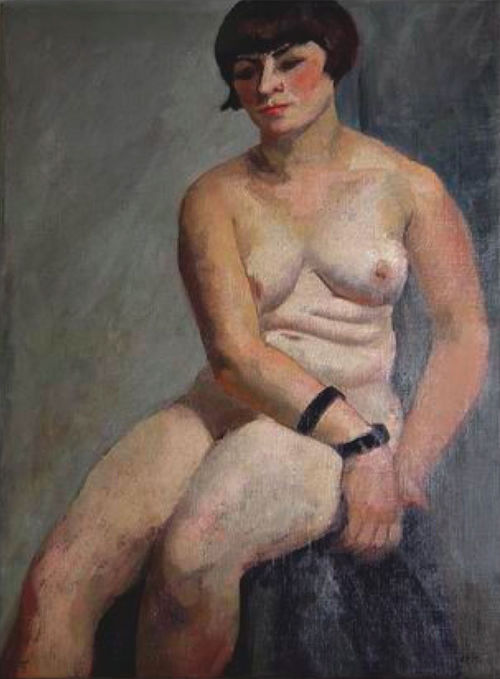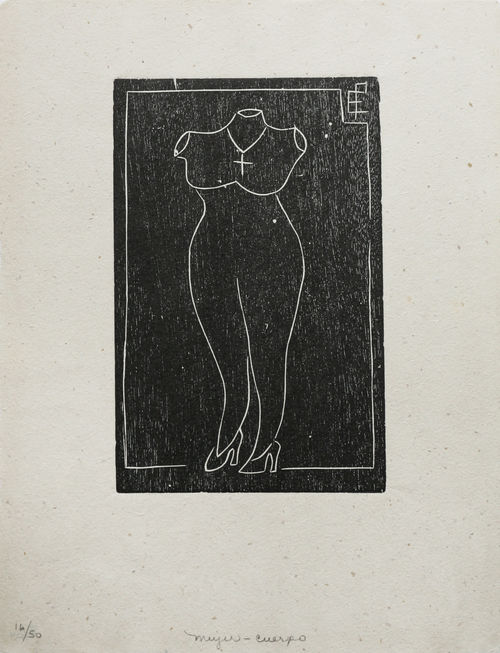One Hundred Times One
There is nothing more counterrevolutionary than the whorehouse.#
—Emilia Prieto
In 1933 María Isabel Anita Carmen de Jesús Vargas Lizano—a child at the time—ran away from her grandparents' home in the village of Santa Bárbara de Heredia, in Costa Rica. According to the writer Sergio Ramírez, the girl never tried to conceal her taste for women, even though her father had hoped that her grandparents would be able to beat it out of her. At the age of fourteen, Isabel bought a one-way ticket to Mexico City, where years later she would be known as Chavela Vargas. In his book La fugitiva (2011), Ramírez tells the story of the famous singer and those of the writer Yolanda Oreamuno and the poet Eunice Odio, who came before her. All three women had to flee their native Costa Rica in order to find themselves.
The fate of these three "fugitives"—like those of so many other female creators throughout Central America—was marked by the conventions of the times as they developed independent thinking at odds with existing norms. It is strange—if not outright contradictory—that women participated in the large networks of intellectuals on the isthmus, the breeding grounds of the new secular republics in the first half of the twentieth century. Intellectual and political elites were influenced by dynamic associations of Central American scholars, the thinking of Masonic lodges, theosophical and spiritualist societies, and literary clubs, all of which attempted to give shape to forms of political representation capable of combating dictatorship.# Associations with mostly female membership, like the Sociedad Gabriela Mistral in Guatemala, were formed in the 1920s, 1930s, and 1940s; the articles they published in magazines and in newspapers laid the groundwork for women's suffrage.
Rarely, however, did those struggles venture into that "other" and historically prohibited terrain, one stigmatized for the sake of patriarchal control: the terrain of the female body and sexuality. Due to the defiant nature of their works, artists such as the painter Antonia Matos Aycinena (Guatemala, 1904–1994) and the poet, essayist, art critic, communist activist, oral researcher, singer, and printmaker Emilia Prieto (Costa Rica, 1902–1986) were silenced for decades for daring to show what was considered shameless and private. As an outstanding student at the École des Beaux-Arts in Paris in the late 1930s, Matos Aycinena made a series of studies of male and female nudes (fig. 1)—beautiful images of fleshy bodies both black and white—that she showed at Galerie Zak, drawing the attention of intellectuals. A brilliant future lay ahead. The mounting political tensions in Europe that would culminate in the rise of the National Socialist Party in Germany and the outbreak of World War II were reason enough for her father to decide that Antonia and the rest of the family would return to Guatemala. Once she had settled in Guatemala City, Matos Aycinena organized a show of her work in order to reinsert herself into her country's cultural scene. The show opened at the exhibition hall of the Academia Nacional de Bellas Artes in Guatemala City on June 9, 1934. Seven of the thirty-three works exhibited were from the group of nudes she had painted during her student years.# The uproar that the show occasioned could not have been expected. The painter's irreverence and audacity led the academy's authorities to censor the exhibition, closing it before the scheduled date. Under the ironclad control of the dictator Jorge Ubico, the authorities stated that the themes of the show were unseemly for a "young woman of high birth."#
Matos Aycinena took down her works and put them away. She disappeared from public life, withdrawing to her family's farm on the southern coast for years. There are a number of legends and anecdotes about her life, however. Before leaving for Paris, for instance, a local artist had asked her to pose for a portrait. Her nude body was the source of inspiration for four female figures that adorn a mausoleum—cause for nightmares in Guatemalan high society to this day. It was not until 1993, one year before her death, that the silence surrounding the artist's work was broken, the same silence that shrouded the memory of Emilia Prieto. Throughout the 1930s and into the 1940s, Prieto produced hundreds of small woodcuts (fig. 2) published alongside articles, news stories, and other texts in the Repertorio americano, a journal of criticism. As pioneering as it was radical, her vision was ignored for many years. Society preferred to remember her as a nice lady dedicated to the study of folklore rather than as a woman "indicted for the crime of treason against the state," as a government document from 1948 states.#
If, in the first half of the century, the social and political engagement of women clashed with the actions and discourses of the state and of the liberal bourgeoisie, starting in the 1960s new generations began to reap the benefits of those earlier conquests and to place at the center of debate issues that had been systematically ignored. Margarita Azurdia, Victoria Cabezas, and Sandra Eleta—from Guatemala, Costa Rica, and Panama, respectively—were among the artists who started going against the grain of history and questioning, in their works and their actions, a classic understanding of progress in art history as based on the notion of the white male genius artist. Those three artists formed part of the generation that emerged on the world scene in the context of the Cold War and the triumph of the Cuban Revolution in 1959, one of the most important political events in Latin American history. In the framework of anticommunism and US interventions in Central America in the 1960s, 1970s, and 1980s, armed movements emerged and grew in Guatemala, Nicaragua, and El Salvador. The Movimiento Revolucionario 13 de Noviembre—the oldest guerrilla movement in the region—was founded in Guatemala in 1960. In 1979 the Frente Sandinista de Liberación Nacional ousted the Somoza family, the oldest dictatorship in Central America. In the early 1980s El Salvador witnessed the outbreak of an armed conflict between the military and an insurgency led by the Frente Farabundo Martí para la Liberación Nacional. While no major oppositional political fronts arose in Costa Rica or Honduras, those countries were affected by the hardships the wars brought to the entire isthmus. Furthermore, due to its proximity to Cuba, the region was geographically and strategically important to the United States, which informed its economic and geopolitical relations.
Despite all the adversity that the conflicts brought, the 1960s and 1970s were fruitful decades for the art scene. Indeed they witnessed the development of projects that are now crucial points of reference in art history. The fact that the process of constructing modern imaginaries—an outgrowth of reflection on the world and local scenes—was ongoing in the region is evident in, among other things, the founding of groups like Vértebra in Guatemala (1969–71); the choice of Luis Díaz as the recipient of the Premio Latinoamericano Francisco Matarazzo Sobrinho at the 11th São Paulo Bienal (1971); and polemical events like the first edition of the Bienal de Pintura Centroamericana, held in San José, Costa Rica, in 1971.# The scene in Guatemala was as dynamic as it was sophisticated. There was significant artistic experimentation and a circuit of independent galleries; polemical manifestos were issued and venues of debate opened. Despite so many adverse circumstances, among them widespread partisanship and discourses steeped in leftist ideologies, the artistic models that emerged in those years were—it is now clear—by no means the result of disinformation.
Excerpted from Radical Women: Latin American Art, 1960–1985. Copyright © 2017 by the Armand Hammer Museum of Art and Cultural Center, Inc. Published by DelMonico Books, an imprint of Prestel. The full essay can be found in the exhibition catalogue, available here.
Epigraph: Emilia Prieto, quoted in Sila Chanto, "La caligrafía de la conciencia: Otra lectura sobre Emilia Prieto Tugores," in Tres mujeres, tres memorias: Margarita Azurdia, Emilia Prieto, Rosa Mena Valenzuela (San José, Costa Rica: Teorética, 2009), 71.
According to Marta Elena Casaús Arzú, these networks stretched throughout Central America, and Latin America as a whole, with ties that allowed intellectuals from the isthmus to move beyond their provincial isolation. For further information, see Casaús Arzú, "La creación de nuevos espacios públicos a principios del siglo XX: La influencia de redes intelectuales teosóficas en la opinión pública centroamericana (1920–1930)," in Las redes intelectuales centroamericanas: Un siglo de imaginarios nacionales (1820–1920), by Marta Elena Casaús Arzú and Teresa García Giráldez (Guatemala: F&G, 2005), 71–121.
Information from Francisco Aguirre Matos and Desirée Berger de Aguirre, La obra de Antonia Matos, 8th ed. (Guatemala, 2013), 21.
Jorge Ubico Castañeda became president of the Republic of Guatemala in 1931. After thirteen years of authoritarian rule, discontented civilian groups began to exert pressure on the dictator and to criticize his government. On June 1, 1944, Jorge Ubico resigned and named a triumvirate to take over the government. On October 20 of that same year, the Revolución de Octubre, a military-civilian movement, broke out. It overthrew the de facto government and ushered in a period of state modernization known as the Democratic Spring.
Virginia Pérez-Ratton, "Gráfica de la radicalidad visionaria," in Tres mujeres, tres memorias, 65.
The members of the biennial's jury were José Luis Cuevas, Oswaldo Guayasamín, Armando Morales, Fernando de Syzlo, and Marta Traba. Of the five prizes stipulated, the only ones awarded were the Gran Premio Centroamericano de Pintura, which went to Luis Díaz from Guatemala for his work Guatebala, and the Premio Nacional, which went to Rolando Castellón from Nicaragua. The other three prizes were declared null and void, sparking controversy. Traba offers an account of what happened in her emblematic "Por qué Guatemala se tragó la bienal," reprinted in El Gukumatz en persona: Luis Díaz, más de 45 años dedicados al arte y la arquitectura en Guatemala, ed. Luis Diaz (Guatemala, 2007), 45–46.






